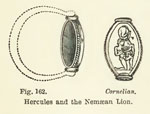Previous First Next
SALAMIS IN THE ISLAND OF CYPRUS.
BY ALEXANDER PALMA DI CESNOLÀ, F.S.A.,
page 79
5. Oval intaglio for a ring. A full-length figure of the god Mars, or Ares, without drapery, to the left, helmeted, and holding a spear and shield. Half-inch long. Cornelian. (See Plate xv, fig. 80.)
6. Oval intaglio. A full-length figure of the goddess 1 From Journal, vol. iii, p. 330.
Minerva to the left, draped and helmeted, and holding distaff and lance. Early workmanship. Half-inch long. Cornelian or hyacinth. (See Plate xv, fig. 70.)
7: Oval intaglio for use as a signet. The subject appears to be the goddess Minerva, full length, with helmet and lance, facing to the right. Before the goddess is a shield resting upon a column. The date of this is about the second century B.C. 5-8ths inch long. Bloodstone. (See Plate xv, fig. 67.)
8. Oval for a ring. Finely-executed head of a warrior or the goddess Minerva, to the right, helmeted. The date may be referred to the first century before Christ (fig. 158). 7-16ths inch long.
9. Convex oval intaglio. A full-length figure of a goddess with a weapon, perhaps Minerva (fig. 159). Very archaic. 3-4ths inch long.
 10. Oval intaglio. A full-length figure of Minerva, helmeted, to the left, holding up or supporting a warrior with a spear in his hand (fig. 160). 5-8ths inch long. 10. Oval intaglio. A full-length figure of Minerva, helmeted, to the left, holding up or supporting a warrior with a spear in his hand (fig. 160). 5-8ths inch long.
11. Convex oval intaglio. A figure of Athene Nikephoros, holding a spear and shield. Half-inch long. Cornelian.
12. Convex oval intaglio gem. The subject is Athene Nikephoros, engraved in a good style of art. 3-8ths inch long, set in an ancient gold finger-ring. Deep red cornelian.
13. Oval intaglio. A full-length figure of the goddess Demeter, or Pomona, holding a basket of fruit and ears of corn. The date is the second century A.D. 9-16ths inch long. Cornelian. (See Plate xv, fig. 69.)
 14. Convex oval intaglio. A full-length female figure, perhaps a goddess, holding a spear, and resting her right hand on a term or altar. 1 inch long. Purple paste. 14. Convex oval intaglio. A full-length female figure, perhaps a goddess, holding a spear, and resting her right hand on a term or altar. 1 inch long. Purple paste.
15. Convex oval intaglio. A full-length figure of a goddess with uncertain attributes. The edge is ornamented with a small beading or dotted border. 7-8ths inch long. Iridescent glass or paste.
16. Oval intaglio gem. A figure of the god Hermes, or Mercury, with a caduceus, engraved in an elegant archaic style. 7-16ths inch long. Hyacinth. (See Plate xv, fig 82.)
17. Oval intaglio. Hermes, or Mercury, with caduceus and wallet, as in Museo Borbonico, torn, vi, tav. 2. Figured in Smith's Class. Diet. 3-8ths inch long, set in an ancient plain massy gold ring. Hyacinth.
18. Oval convex intaglio. Mercury, undraped, to the right, holding a sacred branch as the emblem  of peace. This emblem was attributed to Mercury by the Fetiales, who never recognised the identity of Mercury with Hermes of the Greeks, although the Romans of later times transferred all the attributes and myths of Hermes to their own god. Quarter-inch long, set in a plain and massy gold finger-ring of small dimensions and ancient workmanship. Sard. of peace. This emblem was attributed to Mercury by the Fetiales, who never recognised the identity of Mercury with Hermes of the Greeks, although the Romans of later times transferred all the attributes and myths of Hermes to their own god. Quarter-inch long, set in a plain and massy gold finger-ring of small dimensions and ancient workmanship. Sard.
19. Oval, set in gold, with the holes for the insertion of the hoop of a swivel ring. This subject is Hercules and the Nemǽan lion. The workmanship is Greek, and there is an elegant style of art in the treatment of this beautiful intaglio. The date may be placed at the third century B.C. 3-4ths inch long. Cornelian.
20. Oval intaglio, engraved on both sides. The obverse has a representation of Hercules strangling the Nemǽan lion, the first1 of the twelve labours performed at the bidding of
1 " Prima Cleonǽi tolorata œrumna Leonia". Auson., Idyll, xix; cf. also Apollodor. ii, 5, § 1. Eurystheus. Behind the semi-divine hero is his attribute the club, which he had employed in vain against his foe before he strangles it. The arrangement of this scene is exactly the
same as that engraved by Smith1 from a Roman lamp. On the reverse the letters  The H probably stands for ΗΡΑΚΛΗC. It is difficult to conjecture the signification of the κ. 3-8ths inch The H probably stands for ΗΡΑΚΛΗC. It is difficult to conjecture the signification of the κ. 3-8ths inch
Previous First Next
|